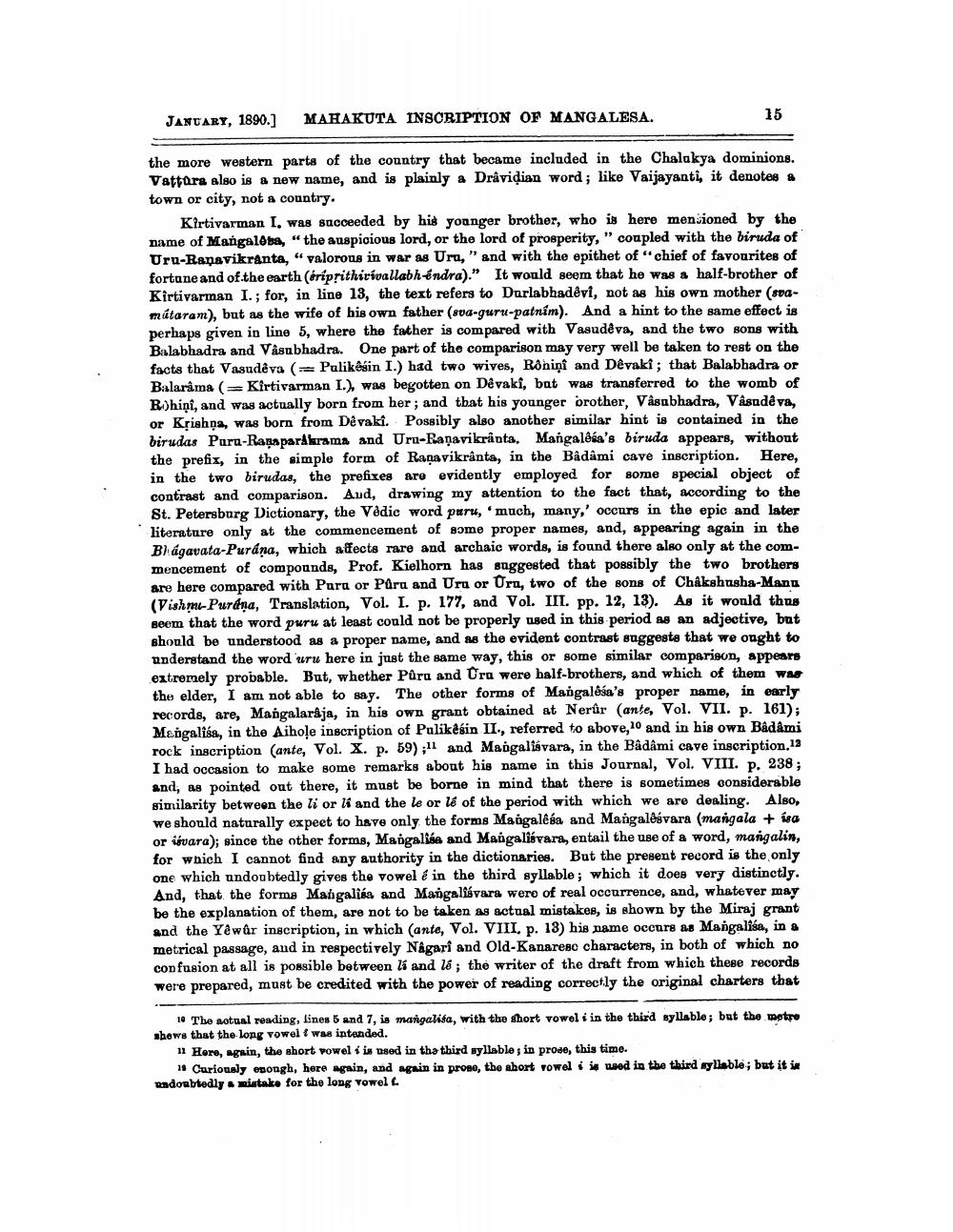________________
JANUARY, 1890.]
MAHAKUTA INSCRIPTION OF MANGALESA.
15
the more western parts of the country that became included in the Chalukya dominions. Vattare also is a new name, and is plainly a Dravidian word; like Vaijayanti, it denotes town or city, not a country.
Kirtivarman I, was succeeded by his younger brother, who is here mensioned by the name of Mangalesa, “the auspicious lord, or the lord of prosperity," coupled with the biruda of Uru-Ranavikranta, “valorous in war as Uru," and with the epithet of "chief of favourites of fortune and of the earth (éripsithirivallabh-endra)." It would seem that he was a half-brother of Kirtivarman I.; for, in line 13, the text refers to Durlabhadevi, not as his own mother (SDQmátaram), but as the wife of his own father (sva-guru-patném). And a hint to the same effect is perhaps given in line 5, where the father is compared with Vasudêva, and the two sons with Balabhadra and Vâsubhadra. One part of the comparison may very well be taken to rest on the facts that Vasudeva ( Pulikesin I.) had two wives, Rôniņi and Dêvaki; that Balabhadra or Balarama (= Kirtivarman I.), was begotten on Devaki, but was transferred to the womb of Rhini, and was actually born from her; and that his younger brother, Våsubhadra, Våsude va, or Krishna, was born from Dêvaki. Possibly also another similar hint is contained in the birudas Puru-RansparAkrama and Uru-Raņavikrânta, Mangalêsa's biruda appears, without the prefis, in the simple form of Ranavikrânta, in the Bâdami cave inscription. Here, in the two birudas, the prefixes are evidently employed for some special object of contrast and comparison. Aud, drawing my attention to the fact that, according to the St. Petersburg Dictionary, the Vedic word paru, 'much, many,' occurs in the epic and later literature only at the commencement of some proper names, and, appearing again in the Bhagavata-Purána, which afects rare and archaic words, is found there also only at the commencement of compounds, Prof. Kielhorn has suggested that possibly the two brothers are here compared with Pura or Púru and Uru or Uru, two of the sons of Chákshusha-Mann (Vishmi-Purina, Translation, Vol. I. p. 177, and Vol. III. pp. 12, 13). As it would thng seem that the word puru at least could not be properly used in this period as an adjective, but should be understood as a proper name, and as the evident contrast suggests that we ought to understand the word 'uru here in just the same way, this or some similar comparison, appears extremely probable. But, whether Puru and Cra were half-brothers, and which of them was the elder, I am not able to say. The other forms of Mangaléśa's proper name, in early records, are, Mangalaraja, in his own grant obtained at Nerür (ante, Vol. VII. p. 161); Mengalisa, in the Aihoļe inscription of Pulikesin II., referred to above, 10 and in his own Badami rock inscription (ante, Vol. X. p. 59):11 and Mangaliavara, in the Badami cave inscription,13 I had occasion to make some remarks about his name in this Journal, Vol. VIII. p. 238; and, as pointed out there, it must be borne in mind that there is sometimes considerable similarity between the li or li and the le or lé of the period with which we are dealing. Also, we should naturally expeet to have only the forms Mangalêba and Mangalêsvara (mangala + isa or isvara); since the other forms, Mangalisa and Mangalióvara, entail the use of a word, mangalin, for which I cannot find any authority in the dictionaries. But the present record is the only one which undoubtedly gives the vowel é in the third syllable; which it does very distinctly. And, that the forms Mangalîsa and Mangaliśvara were of real occurrence, and, whatever may be the explanation of them, are not to be taken as actual mistakes, is shown by the Miraj grant and the Yêwûr inscription, in which (ante, Vol. VIII. p. 13) his name occurs as Mangalisa, in a metrical passage, and in respectively Nagari and Old-Kanarese characters, in both of which no confusion at all is possible between li and lé; the writer of the draft from which these records were prepared, must be credited with the power of reading correctly the original charters that
10 The sotaal reading, lines 5 and 7, is mangalita, with the short vowels in the third syllable; but the metro shows that the long vowel I was intended.
11 Horo, again, the short vowel 1 is used in the third syllable, in prose, this time.
11 Curiously enough, here again, and again in prose, the short vowel is weed in the third syllable; but it is undoubtedly . niatake for the long vowel




